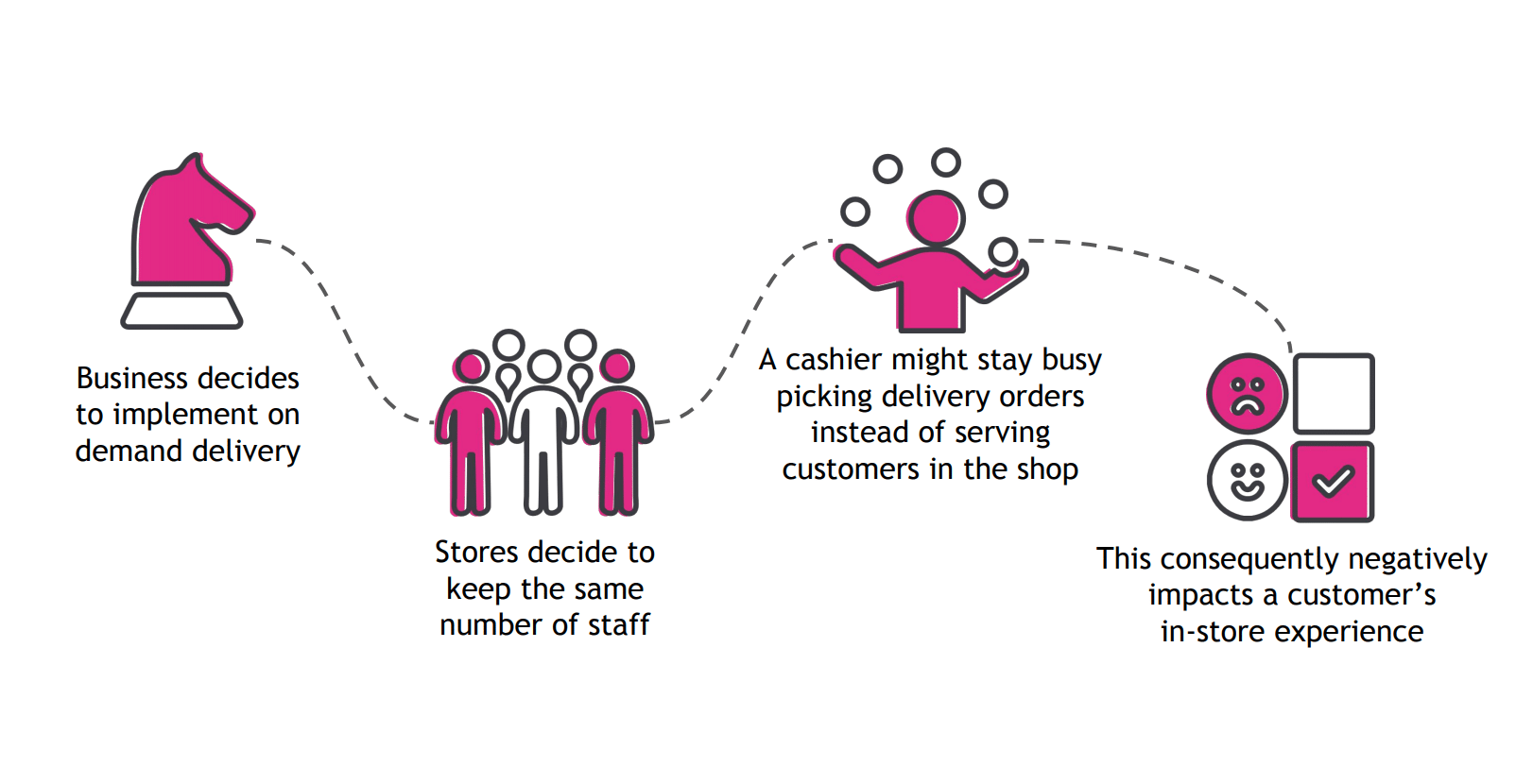Grocery delivery has seen rapidly changing customer behaviours over the last year; the number of UK consumers placing online orders doubled in the first few months of the pandemic.
On-demand delivery – bespoke, quick, tailored and business optimisation
On-demand delivery – bespoke, quick, tailored and business optimisation
Grocery delivery has seen rapidly changing customer behaviours over the last year; the number of UK consumers placing online orders doubled in the first few months of the pandemic.

Meet the author
Grocery delivery has seen rapidly changing customer behaviours over the last year; the number of UK consumers placing online orders doubled in the first few months of the pandemic. In particular, research shows that prior to the pandemic, only 3-4% of grocery customers were using apps – this figure has now escalated to 10-15%. We still don’t know what the future of online grocery shopping will look like, but it’s possible that a large proportion of new online shoppers will develop a habit that continues even after life returns to normal. It’s therefore crucial for retailers to maintain a sustainable solution to continue to meet growing demand.
A major challenge faced by supermarkets around delivery, and specifically on-demand delivery, is that this service is not cost effective for a standard business model. Grocery prices online and in-store remain largely the same, but with the extra costs of picking and delivering, margins remain pretty low. In addition to this, competitive delivery prices amongst peers in an oligopolistic market makes it very easy for customers to switch suppliers if another provider can offer them a cheaper, quicker option.
So, how can you roll out on-demand delivery that retains customers and doesn’t break the bank? On-demand delivery will ensure you keep pace with changing customer expectations, and competitors. Staying ahead of the curve will also improve new customer acquisition. However, several factors need to be taken into consideration to make it a cost effective solution:
Understanding your customer and business needs
As we outlined in part 1 of our cost optimisation series, successful cost optimisation needs to be built on a foundation of customer experience. The first key step is to establish which trends this year are the right fit for both your customers and your business. What does success look like for you? What is business critical and what is a stretch goal? Speak to your customers and involve them as early as possible to help you define key outcomes and measures of success. If the appetite for on-demand delivery is there, conduct an assessment on your current and expected resource requirements compared to the customer satisfaction that on demand delivery would bring. Consider the secondary impacts this might have on the business (e.g. your profit margins), your employees (e.g. their day to day experience) and most importantly, your customers. For example:

If your assessment indicates that the cost will negatively impact your customers and business, it may be more cost effective to invest in strengthening your current delivery solutions instead. On the other hand, if on demand delivery is not an option at all, then customers may choose convenience over loyalty and switch to an alternative supplier. It’s important to strike the correct balance; by operating efficiently whilst investing in an improved customer proposition, you can create a customer experience which ultimately drives loyalty and customer retention whilst optimising the cost of sale.
The on-demand partnership model e.g. Co-op and Deliveroo, Morrisons and Amazon
If you’ve partnered with another organisation, you will have already dramatically reduced the initial investment required to implement the solution. For example, a delivery partner will have the necessary infrastructure in place to provide nationwide, on demand deliveries whilst you can provide the products. This way, both parties can provide the service they are most cost-efficient at leading to greater profits from sales. However, the type and terms of the supply arrangement will be crucial in ensuring you have a cost efficient solution in the long term; for example, whose responsibility will picking the items be? Store layouts are not usually designed for maximum picking efficiency, meaning that your staff might get caught up in this task instead of serving in store customers. Another example might be the platform where your products are sold; will customers use the delivery provider’s app, or will you need to build your own? Using the aforementioned assessment will give you a view of your expected capacity and available resources to inform such decisions.
Implementing the service yourself, whilst keeping costs minimal
Providing the service yourself can be a good way to ensure that you are in control of the end-to-end delivery service. This can enable you to take advantage of cost savings that may arise from providing services at scale. For example, you can leverage existing digital infrastructure you may have from your current grocery delivery service and alter this to incorporate on-demand delivery instead of maintaining a separate site that you might have created for testing purposes. Other benefits include:
- Decreased dependency on other providers: in a partnership, there is a risk that if something goes wrong, you will be just as affected as your partner.
- Control over prices and margins: You won’t have to share your profits with another company. Furthermore, you will be able to set your prices as you wish. On demand delivery partners often have higher prices, or extra fees that may disincentive your customers.
Finding out what your customers want will be a key element of success in this model. Collect feedback early and frequently to help you make key decisions, such as whether you need to offer a subscription delivery service or not. Tesco for example, offers both a range of one-off slots as well as a monthly ‘Delivery Saver’ option in their standard grocery delivery service, giving customers plenty of choice. If you’d like to know more about how to incorporate CX into your solution, this article is a great place to start.
Both models have their benefits and drawbacks. It may be that a partnership option is a good short-term option to meet customer needs, whilst you figure out a more cost efficient long-term one. Ultimately, this solution needs to meet your customers needs and should be tailored to do so. If you’d like to know more about cost optimisation or service design, get in touch with us below.
This post was originally written by: Ed Kemp Sloan and Priya Radia

